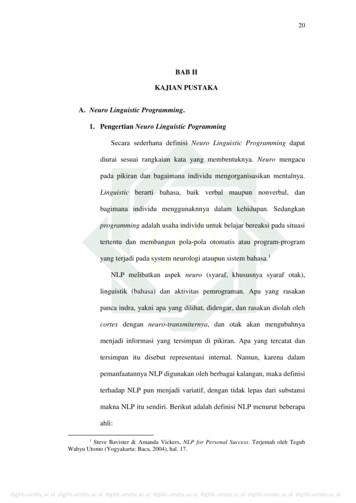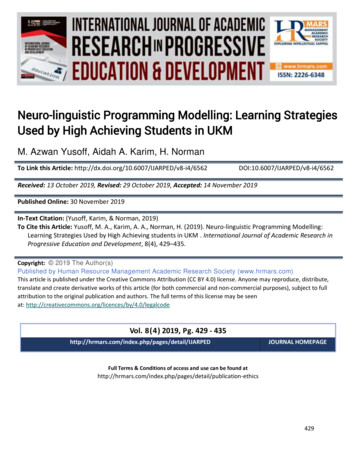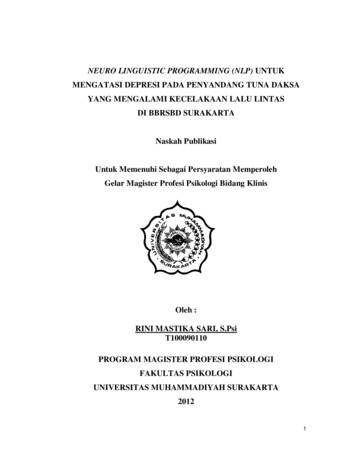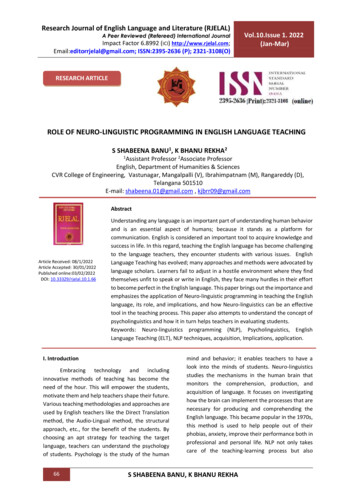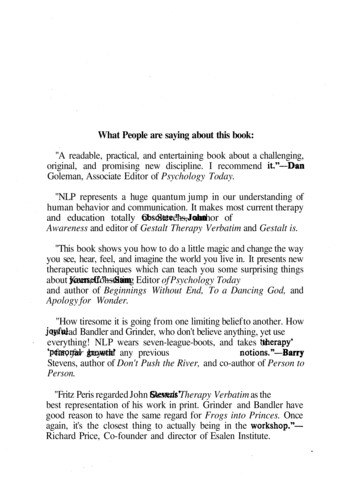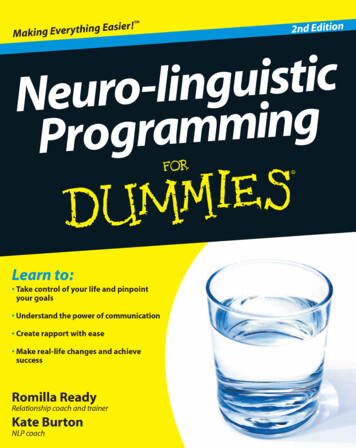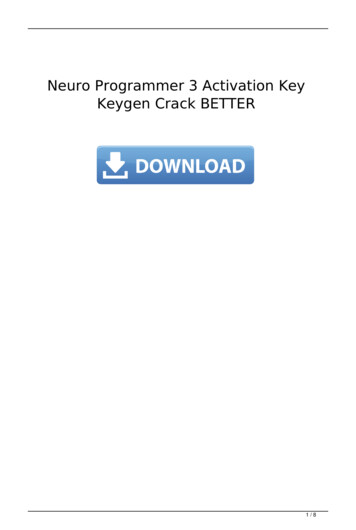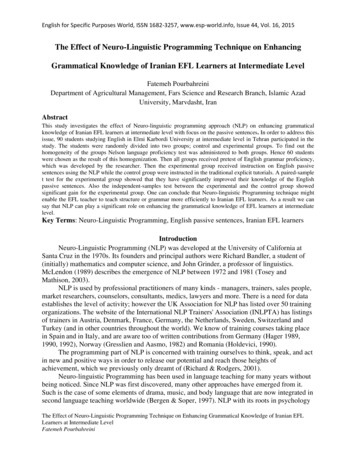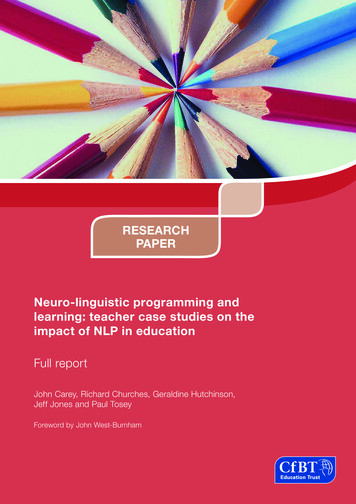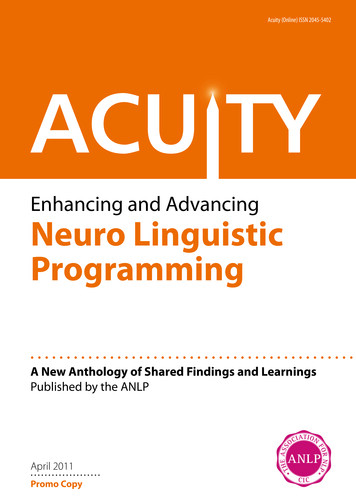
Transcription
Acuity (Online) ISSN 2045-5402Enhancing and AdvancingNeuro LinguisticProgrammingA New Anthology of Shared Findings and LearningsPublished by the ANLPApril 2011Promo Copy
ACUITYEnhancing and AdvancingNeuro Linguistic ProgrammingA New Anthology ofShared Findings and Learningspublished by the ANLPPromotional Edition
ACUITYEdited by Joe Cheal41a Bedford Road, Moggerhanger, Beds, MK44 3RQ, UK.Tel ( 44) 1767 640956Email joe.cheal@gwiztraining.comThe Association for NLPApsley Mills Cottage, Stationers Place, Hemel Hempstead, HP3 9RH, UK.( 44) 20 3051 6740www.anlp.orgReview PanelSteve AndreasRichard BolstadRobert DiltsL. Michael HallJames LawleyJohn SeymourRobert SmithLisa WakeSubmissions are welcome. Please email the Editor for Contributor Guidelines.The views expressed in Acuity are those of the contributor and do not necessarily reflect the opinionsof the ANLP or the Editor.Articles remain the copyright of the contributor. All other contents are (c) ANLP 2010. No part of thispublication may be reproduced or transmitted in any form or by any means, electronic, mechanical,photocopying, recording and/or otherwise without the prior permission of the publishers. This PDFmay not be lent, shared, resold, hired out or otherwise made available in any form without the priorconsent of the publishers.
This promotional copy of Acuity includestwo articles from:ACUITY Vol.1, No.1The full journal includes the following:Journal ContentsArticleAuthorPageNLP Patterns and PrinciplesRichard Gray6“If only God would give us aPenny Tompkins & James Lawley17The Role of Moods in NLPJoe Cheal28The Four Pillars and CoachingAngus McLeod377 2 Keys To Becoming A World-L . Michael Hall49Richard Bolstad61sign”: The Role of MetaCommentsClass CoachThe “How” Behind “The Secret”
This promotional copy of Acuity also includestwo articles from:ACUITY Vol.2, No.1The full journal includes the following:Journal ContentsArticleAuthorPageAffirmations or QuestionsRichard Bolstad5Pseudo-orientationsRichard Gray12Joining Up The Work of DavidJames Lawley27Space, Time & CertaintyLucas Derks42Benchmarking as NLPL . Michael Hall54Landscape of ExperienceJoe Cheal60Questions about Meta-Susie Linder-Pelz78Blane Savage92GroveExcellenceProgramsCreative Practice Pedagogy
Editing Notes: When Giants SangOnce upon a time, not only did the Giants of NLP walk the earth, but they also sang toeach other across and around the world. They expanded their fields through sharingarticles in journals like NLP World and Anchor Point. They thrived on exploring andapplying NLP models and developing new concepts and ideas.But then one day the publications stopped.Whilst the NLP Giant population grew, many of the Giants formed their own personalsites and people were welcome to visit if they could find them. Every so often, some of theGiants would walk the earth and meet to share their ideas and developments with thepeople. Although the Giants shared their ideas, their songs were rarely heard.Having enjoyed the Giants’ songs, one person missed the joy of the journals and thesharing of giant ideas. And one morning he woke up with a positive intention and a wellformed outcome, determined to hear the Giants sing again. A new journal with newarticles perhaps a new legacy for NLP. And so, in partnership with the ANLP, Acuitywas conceived.Acuity is designed to sit between Rapport magazine and the Current Research in NLPjournal. The aim of Acuity is to provide an opportunity for authors and innovators toadvance the field of NLP in sharing their findings, learnings and developments: newmodels, techniques, applications, refinements and new perspectives to old themes.I wish to thank the panel: Steve Andreas, Robert Dilts, L. Michael Hall, James Lawley,Robert Smith and Lisa Wake for their time and their support. And I wish to thank thecontributors without whom the journal would have been an empty experience.Like some of you, I am an outcome- oriented creature and for years I wanted a journal.Now, with the help of some fantastic people, here you are.Enjoy, be brilliant and shine on.Joe ChealEditor of Acuity.
Words from the ANLP“The whole is greater than the sum of its parts” – a phrase often used in NLP and indeed,Richard Gray even refers to this in his article.This is certainly the case for Acuity, which makes this a great anthology, because everyarticle is already ‘great’ as a standalone piece. So to have them combined into a collectionof insights into NLP and Coaching is truly remarkable and a testament to all who havecontributed.The other thing regularly alluded to is the need for greater collaboration in the field ofNLP. Robert Dilts talks about Generative Collaboration and Acuity is definitely anexample of that. Acuity was conceived, nurtured and delivered with a true spirit ofcollaboration, and we had no idea when we started exactly where we would end up,because the small ideas developed into bigger plans, nurtured by a shared enthusiasm andpassion for NLP.I would especially like to thank Joe for his commitment, drive and enthusiasm in creating,co-ordinating and editing Acuity. Thank you to our full review panel, who have embracedthis concept with conviction and a commitment that enabled us to take Acuity andtransform it into a reality. And as Joe says, thank you to the contributors because ofcourse, without the enormous part they play, there would be no Acuity.Please do continue to generate informative and innovative articles, so that we can continueto develop a strong body of works for the field of NLP to enjoy.Karen MoxomManaging DirectorANLP
6The Role of Meta-Comments‘If only God would give us a sign’The Role of Meta-CommentsPenny Tompkins and James LawleyCartoon reproduced with kind permission of Allan Hirsh,author of Relax for the Fun of it: A Cartoon & Audio Guide to Releasing Stress www.allanhirsh.comDavid Grove, the originator of Clean Language, was an astute observer of his therapyclients. He was the first to alert us to the importance of clients' comments which do notfollow on from the previous statement and which appear incongruous. Grove called thesecomments non sequiturs. We extracted the non sequiturs from a number of verbatim clienttranscripts. We noticed that most of these remarks were a more or less thinly disguisedcomment about what was happening for the client in the previous moment – hence wecalled them meta-comments.
We define a 'meta-comment’ as a verbal or nonverbal expression which refers to what hasjust been experienced. These self-reflections range from the fully conscious and explicit tothe completely unconscious and implicit.Apparently Michael Palin used the term 'meta comment' when he was part of MontyPython's Flying Circus. The Pythons used them to comic effect when an actor would referto the situation their character was in. For example in Monty Python and the Holy Grail,following Sir Galahad's discovery of the Castle Anthrax, Dingo is telling the sad tale of herlife:"Oh, wicked, bad, naughty, evil Zoot! She is a bad person and must pay the penalty. she turns to the camera:"Do you think this scene should have been cut? We were so worried when the boys werewriting it, but now, we're glad. It's better than some of the previous scenes, I think."This is analogous to when clients meta-comment. They interrupt what they are doing topass a judgment, reflect on their knowledge, give notification of a change, or in some otherway reveal something about the current state of their inner world. To understand metacomments you need to extract them from the flow of normal speech and recognise that theclient is commenting on their in-the-moment experience. Because they are embedded inthe client's narratives, meta-comments are somewhat hidden and easily ignored. But toignore them is to miss out on some of the most important signposts for how best toproceed with facilitating this particular client at this particular moment.The following example is from a client who was struggling to come to terms with hernew role as a mother.It's got a new quality about it. It's a very new thing. It's . What I'm finding out with themother role which I love, and it is true I have somehow taken to it naturally, I'm aware thatwhat's creeping in is this sort of more negative side where I will more easily lose myself,the bit that I do know is me which comes through when I feel free, which is quiteinteresting. And before it goes too far where . I don't want to become in some ways likemy mother did, which was really putting her life on hold. And giving in to exhaustion.And I can, I know I have that in me to do. And eventually I think, you know, that's whatkilled her, you know with the cancer, the stuff just ate her up. So . I am strong. I am quite astrong person and I . that works against me sometimes, because I will do things toexhaustion. And then I collapse. There's a negative aspect which comes through asresentment. Because I can be so resentful as well because I can take on things but I'm not,I'm no saint. You know, I will go, 'oh, what about me?'.
8The Role of Meta-CommentsDid you notice any meta-comments? What alerted you to them? What did they pointto? And what would you ask as a result?Penny noted “which is quite interesting” was a meta-comment on “the bit that I doknow is me which comes through when I feel free”. The meta-comment indicated thatthe client’s attention was attracted enough by what she had just said and thought forher to interrupt her narrative and pass comment. As a result of this signposting Pennyused Clean Language to ask:And what about me? And there’s a bit that you know is me that comes through when youfeel free. And when you feel free and you know that bit is me, where is that bit?In case you are interested, the client replied:On my shoulder, sort of here [right hand gestures to right shoulder]. Like a conscience, butnot a conscience. Yes, it's a knowing, yeah it's a knowing. That's interesting. It's funnyidentifying a place because now I can remember when I have . m-m-m, now that'sinteresting. I've, I've, I've heard this before but not known the locality of it.Below are some more examples of client’s meta-comments:This is important.That’s a new option.There must be a place that knows.I realise I need to decide which way to go.God knows.No, that's not what I meant. [self-correcting]Do I want to go there?That’s a hard question.Oh look, there’s no green in the rainbow.Does that make sense?Phew, I’ve gone all hot.I know I shouldn't say this but . so anyway .It's obvious that .It just occurred to me .I can't believe I just said that.Now let me see .[A tap of a watch][A hand over the mouth]The key to understanding the role played by meta-comments is to model what the clienthas had to do with their attention or perception to have made this particular comment.
Meta-comments indicate a momentary shift in perspective (and possibly perceiver)from a more descriptive narrative to a statement with a degree of self-reflection.Because we are remarkably consistent beings and we cannot not be ourselves, thestructure of what we do in the micro (seconds) is often isomorphic with what happensin the macro (days, months, years). In this way meta-comments in the session can beseen as fractals – vignettes that when scaled up retain a similar organisation to how weexperience our 'real life'.From a facilitator's viewpoint, meta comments can be considered as orientation pointersand as messages from the 'wisdom in the system'. In broad terms they can be taken as adirective to:- Continue attending to the current perception (to stay put)- Attend to something else- Not attend to something- Change your way of facilitating (e.g. slow down, speed up, etc.)Since meta-comments are about the client’s relationship with their interior landscape theyoften reveal something about the degree of significance or insignificance the client attachesto a part of their experience.Why 'Meta'?The notion of 'meta' and 'levels of communication' was extensively discussed andutilised by the groups that formed around Gregory Bateson at Stanford University inthe 1950s and at the Mental Research Institute at Palo Alto, California in the 1960s.Strangely, although Bateson regularly mentions meta-communication, metalogues andmetalinguistic messages in Steps to an Ecology of Mind, we could not find the term 'metacomment' in the book.Robert Dilts and Judith DeLozier have attempted to clarify the plethora of meta-this andmeta-that in their Encyclopedia of Systemic NLP [pp. 718-720]:The term meta is a Greek word meaning ‘over’, ‘between’ or ‘above’. In English it is alsoused to mean ‘about’. A ‘meta model’, for example, is a model about other models.‘Metacognition’ is the awareness of one’s own cognitive processes, i.e. cognition aboutcognition.
10The Role of Meta-Comments‘Meta messages’ are messages about other messages, which provide frames or contextmarkers that influence the meaning of those messages. Meta messages are typicallynonverbal and give emphasis or provide cues for how to interpret a verbal message.‘Meta communication’ is communication about communication. For instance, a metacommunication is often a verbal statement that sets a framework around a communicationsituation in the form of rules, guidelines and expectations. A study of the communicationpatterns of effective leaders revealed that almost half of the leaders’ communication wasactually meta communication.It is important to distinguish meta communication from meta messages. Metacommunication is a more macro level process from sending a meta message. A metamessage operates as a kind of subtext that emphasizes certain aspects of a message. If aperson says, “YOU weren’t respecting the rules” it marks the communication as directed tothe ‘who’. Saying “You weren’t respecting the RULES” shifts the emphasis of the messageto the ‘what’. Meta communication, on the other hand, would be saying something like,“Let’s talk about what the rules are, and why we have them.”Meta-comments are another member of the above family of Meta's. They can involvemetacognition, and they can be a meta message or a meta communication. Typically theyare short and interspersed within ordinary speech. If they go on for too long they cease tobe 'meta' and become a comment in their own right. Their primary function seems to be acommunication to self and secondarily a communication to someone else. It is like theperson is externalising their internal dialogue without realising it.Meta-StatesMeta-comments signal a momentary shift to a meta-perspective. L. Michael Hall's model ofMeta-States covers a similar but wider territory than is relevant to this article:In a Meta-State, conscious awareness reflects back onto itself (i.e. self-reflective consciousness).Thinking-about-thinking then generates thoughts/feelings at higher logical levels so thatwe experience states-about-states. Rather than referring to something "out there" in theworld, Meta-States refer to something about some previous thought, emotion, concept,understanding, Kantian category, etc. In this way we layer thought upon thought. [2000,p.4]Examples of meta-states are: Worry about worrying; reasoning about our reasoning; angerat self for being too emotional; etc. While working with meta-states opens up all sorts ofpossibilities, we have found great value in simply regarding a meta-comment as a pointerto what is happening for a client and a guide for how to work with their process.
Congruence/IncongruenceBecause all forms of meta -communication, -messages, -states and -comments operate at adifferent level to that which they are referring to, they can be perceived by the facilitator aseither congruent or incongruent. While incongruence can be considered as evidence thatthe client is operating with incompatible behaviours, desires, values or beliefs, from asystemic perspective if you go to a high enough level you'll find that a functioning systemis always internally congruent. If you cannot see the congruence in what they are saying anddoing that's a signal that there is more for you to model.Categories of Meta-CommentsIn everyday conversation meta-comments rarely become the topic of conversation andan inexperienced listener will barely be aware they have been said. It's like the viewersof a videoed basketball match who are so intent on counting the number of passes theydon't notice a man in a gorilla suit run onto the court. However, once you start to lookfor these particular gorillas you'll see them everywhere.To model the way clients use meta-comments we took the first 20 minutes of eightverbatim transcripts each with a different therapy client and picked out all the metacomments. This resulted in over 120 different examples (excluding repetitions). Onaverage that's one meta-comment every 45 seconds. We categorised these examples intothe following broad headings:WAYS OF KNOWING- The first thing that comes to mind is .- I’m guessing it must be just a kind of .- I’m imagining .COMPARISON- Scale- It’s a big deal for me.- Judgment/Preference- That's odd.- Change/Persistence- Actually in some ways that’s new.TIMEFRAME- At the moment .- I’m at the stage where.- I feel that’s the end of it.LANGUAGING- Let me rephrase that.- I can’t verbalise it.- The question is .CATEGORIES OF EXPERIENCE- That’s the pattern.- I’ve no new ideas.
12The Role of Meta-Comments- My outcome is .CONDITIONAL/POTENTIAL CONTEXTS- I would like that to be true.- If only I could get some new insight.- I might do something about it.TO FACILITATOR DIRECTLY- No, that doesn’t actually feel right.- Let me think about that.- Bear in mind .NONVERBAL- [Laughter at]- [Tears about]- [A sigh]For a full list of the meta-comments by category 1/Pattern-level commentsThere is an additional category of meta-comment that rarely occurs in the first 20 minutesof a client's first session but which warrants special attention. These are comments at apattern-level of organisation:That’s like my whole life.I’m back to square one.I can’t stop running round in circles.How long am I going to complain about this?I realise it's never going to work.Here I go again.It’s the same problem in a different guise.Comments like these are especially important because they mark out that the client isperceiving at a pattern level. With skilful choice of questions you can facilitate them tostay at that level. By transcending and including the multitude of lower-level componentsand examples they are working strategically. And when the pattern changes the effectswill filter down so they think, feel and behave differently across a range of contexts – someof which may never have been mentioned.Common signals for meta-commentsCareful observation suggests that there are behaviours that often mark out a metacomment from other language:
The person's body often moves slightly backwards or upwards.There is a change in their tonality.There is a discontinuity in the flow of their sentences.The comment has an 'about-ness' to it.You may also notice a subtle internal sense that something different – a kind of mismatch– has just happened. This will be you noticing that the client's meta-comment has changedthe frame for a second or two. With practice you can sensitise yourself to notice these cuesand increase your ability to choose whether or not to respond to the meta-comment. Todevelop these skills we recommend you review a transcript, highlighting the metacomments only. One indicator of a meta-comment is to consider whether the client'sdescription makes sense without that comment. If you were to remove all of the metacomments from a transcript and hand it to someone else they wouldn't know anythingwas missing. This, however, does not mean they are unimportant.Working with meta-commentsMost of the time you can just note a client's meta-comment and use it to update yourmodel of their model of the world. This will help you attend to what the client isattending to, and be a guide to where it would be useful for the client's attention to gonext.Hearing a client meta-comment can alert you to consider: What just happened? Howdid they do the shift? What happened just before the shift?. By ‘reverse engineering'what the client has likely had to do with their attention you can get an embodied senseof how their thinking is organised in that moment.Occasionally, however, you may decide to utilise the meta-comment more directly.David Grove suggested that meta-comments have "a short half-life". They decay quicklyand soon disappear from the client's awareness unless they are attended to. So if youare going to refer to them you need to do so immediately after they have happened.Below is a simplified framework for doing this1. Notice/recognise the meta-comment.2. Model the comment in relation to the current organisation of the client’s interiorlandscape and context of the session.3. Consider whether to:
14The Role of Meta-Commentsi. Utilise the comment directlyii. Follow the direction suggested by the meta-commentiii. Deliberately not follow the direction implied by the meta-comment.4. If you decide to pursue one of the options in 3, we recommend you first check that yourintention to utilise the meta-comment relates to their desired outcome. Then you canchoose how you are going to do this. For example, using Clean Language, you couldrespond to a client who says:Client: I've just realised I need to decide which way to go.Facilitator:i: And what kind of ‘realised’ is that ‘realised’?ii: And then what happens?iii: And where could the ‘need to decide’ come from?Ways Meta-Comments can be utilisedOnce you have decided you are going to make use of a meta-comment you have lots ofchoice about how to do that. Below we list some examples to give you a flavour of how weuse Clean Language to utilise verbal and nonverbal meta-comments.Any meta-comment- Repeat only the meta-comment and pause.- Or ask: And is there anything else about that [client’s meta-comment]?"There’s something else I can’t quite grasp."- Do nothing, and wait to see what happens.- Or ask: And then what happens?"I’m trying to do this in bits."- And how many bits?- And what kind of trying is that trying?"Both elements are important."- Make sure that both elements are explored.- Or ask: And how do you know both elements are important?"I know this pattern."- And when you know this pattern then what happens?- And given you know this pattern, what would you like to have happen?"If I'm honest ."- And what happens just before you're honest?- And where does being honest come from?
"[Laugh] I’ve been here before."- And what kind of [laugh] is that [laugh]?- And what could that [laugh] know?- And where could [laugh] come from?"I kind of know that I want something, but [sits back] I don't know what I want."- And what's the difference between [indicate them sitting forward] and [indicatethem sitting back]?- And whereabouts is that know that you want something?A meta-comment that suggests something new just happened.- Interrupt and ask: And what just happened?When there are a lot of meta-comments- Repeat back a list of their meta-comments and ask: And is there anything elseabout all that?- And what happens just before you [list a few meta-comments]?Attending to their own meta-comments is likely be an unusual experience for a client.While it can encourage them to become even more adept at self-reflection and open upareas that were out of their awareness, if overdone clients are liable to become selfconscious. Therefore you need to be selective and to calibrate how useful the client'sresponses to your questions are to them – given their desired outcome.ConclusionPeople meta-comment more frequently than you might expect. In our small survey clientsaveraged more than one per minute. While some people habitually comment on what isgoing on, others rarely do – but when they do it usually signals something significant hasjust happened. Despite their frequency and significance meta-comments are all butignored by most facilitators. In so doing vital information about the current status of theclient's model of the world can be missed.In this paper we have identified several ways to make use of meta-comments, the mostcommon being: Utilising the logic of the meta-commentDirecting attention to the meta-comment itselfMoving time back or forward using the meta-comment as a marker
16The Role of Meta-CommentsNote, our way of utilising a client's meta-comments needs to be distinguished from thetechnique used by some schools of therapy where the therapist meta-comments on a client'sbehaviour, often their non-verbal behaviour.On reflection, perhaps the most significant kinds of meta-comments are those that indicatethe client is operating at a pattern level or that something has just changed. When youdetect one of these cues we recommend that you put on hold anything else you werethinking of doing and keep the client attending to the pattern or the change.Finally, while you can utilise any particular meta-comment, we suggest their main value isto keep you informed about what is happening for the client, and to point to how you cansupport the next step in their unfolding process.BiographyPenny Tompkins and James Lawley have both been UKCP registered neurolinguisticpsychotherapists since 1993. They are also supervisors, coaches in business, and certifiedNLP trainers. They co-authored Metaphors in Mind: Transformation through SymbolicModelling and a training DVD, A Strange and Strong Sensation. They are the founders of TheDeveloping Company and creators of Symbolic Modelling which uses the Clean Languageof David Grove. They can be contacted through their web site: www.cleanlanguage.co.ukReferences Gregory Bateson, Steps to An Ecology of Mind: Collected Essays in Anthropology,Psychiatry, Evolution and Epistemology, Ballantine, 1972/2000Robert Dilts and Judith DeLozier, Encyclopedia of Systemic NLP and NLP NewCoding, nlpuniversitypress.com 2000David Grove, various articles at: ichael Hall, Meta-States: A Domain of Logical Levels, International Society ofNeuro-Semantics 1996/2000James Lawley and Penny Tompkins, Metaphors in Mind: Transformation throughSymbolic Modelling, Developing Company Press, 2000.
The “How” Behind “The Secret”Dr Richard BolstadThe Biggest Mistake In The History Of Personal Development?In many ways, the NLP students who attend my certification courses are a lot betterprepared than students twenty years ago. But in the last four years, a small percentage ofthem demonstrate a child-like naivety that I did not see two decades ago. This small groupresist investigating the “structure of success” and insist that success has no structure. Theymaintain that any questions which leave them feeling uncertain or uncomfortable abouttheir success are best not asked. They consider systematically modelled processes to be adistraction from the one true source of success – a model called simply “The Secret”.In this article I want to examine a personal development model (The Secret) with manysuperficial similarities to NLP. I want to give some of the reasons why I consider it thebiggest mistake in the history of personal development since the invention of organisedreligion. And I want to urge its replacement by well-researched techniques modelled fromthose who actually demonstrate a real ability to “manifest their dreams”.The Secret of Jack Canfield’s Success?The film “The Secret” was released in 2006. The secret referred to in the film’s title is the“Law of Attraction” – that over time you will attract whatever you put your attention on(positive or negative). The level of joy you experience as you focus on something lets youknow what kind of reality you are creating. The original DVD of “The Secret” is focusedon the teachings of Esther and Jerry Hicks, who since 1986 have, they say, channelled agroup of spiritual teachers collectively called Abraham.As thousands of people worldwide grab on to “The Secret” as the final answer to success,new research shows that the more people believe in such a “law of attraction” the less theyachieve. In this article I will show you how this happens, because the Secret aligns withone of the two key traits of high achievers (their focus on the positive) and contradicts theother (their focus on consciously planning action).
18The “How” Behind “The Secret”Firstly, what does “The Secret” tell you to do to put this “Law of Attraction” into practice?In the film, “Chicken Soup For The Soul” co-author Jack Canfield summarizes the film’smessage like this: “Decide what you want, believe you can have it, believe you deserve it,and believe it’s possible for you. And then close your eyes every day for several minutesand visualise having what you already want and feeling the feelings of already having it.Come out of that and focus on what you’re grateful for already and really enjoy it, OK.And then go into your day and release it to the universe and TRUST that the universe willfigure out HOW to manifest it.” He gives the example of his own first great goal – to earn 100,000 in the next year, set at a time when he was earning about 8,000 a year.Canfield says that after he started visualising his goal “ all of a sudden I was in theshower and I was about four weeks into it, and I had a 100,000 idea. It just came straightinto my head. I had a book I had written, and I said “If I can sell 400,000 copies of my bookat a quarter each, that’d be 100,000 . And then, I saw the national enquirer at thesupermarket. I’d seen that millions of times and it was just background, and all of asudden it jumped out at me as foreground and I thought “Wow, if readers knew about mybook, certainly 400,000 people would go out and buy it.” And about six weeks later I gavea talk at Hunter College in New York
Neuro Linguistic Programming A New Anthology of Shared Findings and Learnings Published by the ANLP April 2011 Promo Copy Acuity (Online) ISSN 2045-5402. ACUITY . recording and/or otherwise without the prior permission of the publishers.This PDF may not be lent, shared, resold, hired out or otherwise made available in any form without the prior
